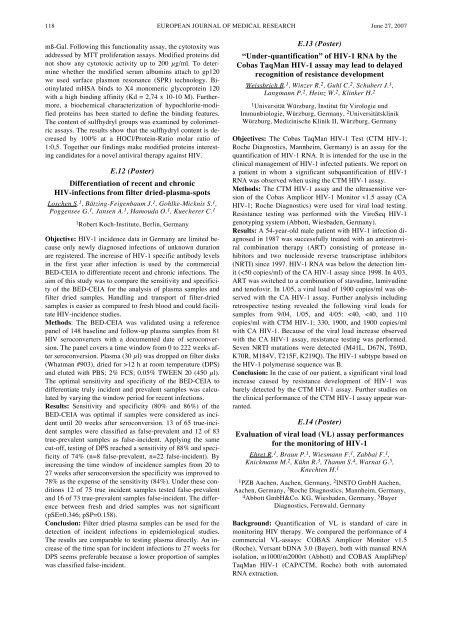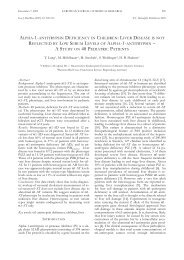European Journal of Medical Research - Deutsche AIDS ...
European Journal of Medical Research - Deutsche AIDS ...
European Journal of Medical Research - Deutsche AIDS ...
You also want an ePaper? Increase the reach of your titles
YUMPU automatically turns print PDFs into web optimized ePapers that Google loves.
118 EUROPEAN JOURNAL OF MEDICAL RESEARCH<br />
June 27, 2007<br />
mß-Gal. Following this functionality assay, the cytotoxity was<br />
addressed by MTT proliferation assays. Modified proteins did<br />
not show any cytotoxic activity up to 200 g/ml. To determine<br />
whether the modified serum albumins attach to gp120<br />
we used surface plasmon resonance (SPR) technology. Biotinylated<br />
mHSA binds to X4 monomeric glycoprotein 120<br />
with a high binding affinity (Kd = 2,74 x 10-10 M). Furthermore,<br />
a biochemical characterization <strong>of</strong> hypochlorite-modified<br />
proteins has been started to define the binding features.<br />
The content <strong>of</strong> sulfhydryl groups was examined by colorimetric<br />
assays. The results show that the sulfhydryl content is decreased<br />
by 100% at a HOCl/Protein-Ratio molar ratio <strong>of</strong><br />
1:0,5. Together our findings make modified proteins interesting<br />
candidates for a novel antiviral therapy against HIV.<br />
E.12 (Poster)<br />
Differentiation <strong>of</strong> recent and chronic<br />
HIV-infections from filter dried-plasma-spots<br />
Loschen S. 1 , Bätzing-Feigenbaum J. 1 , Gohlke-Micknis S. 1 ,<br />
Poggensee G. 1 , Jansen A. 1 , Hamouda O. 1 , Kuecherer C. 1<br />
1 Robert Koch-Institute, Berlin, Germany<br />
Objective: HIV-1 incidence data in Germany are limited because<br />
only newly diagnosed infections <strong>of</strong> unknown duration<br />
are registered. The increase <strong>of</strong> HIV-1 specific antibody levels<br />
in the first year after infection is used by the commercial<br />
BED-CEIA to differentiate recent and chronic infections. The<br />
aim <strong>of</strong> this study was to compare the sensitivity and specificity<br />
<strong>of</strong> the BED-CEIA for the analysis <strong>of</strong> plasma samples and<br />
filter dried samples. Handling and transport <strong>of</strong> filter-dried<br />
samples is easier as compared to fresh blood and could facilitate<br />
HIV-incidence studies.<br />
Methods: The BED-CEIA was validated using a reference<br />
panel <strong>of</strong> 148 baseline and follow-up plasma samples from 81<br />
HIV seroconverters with a documented date <strong>of</strong> seroconversion.<br />
The panel covers a time window from 0 to 222 weeks after<br />
seroconversion. Plasma (30 l) was dropped on filter disks<br />
(Whatman #903), dried for >12 h at room temperature (DPS)<br />
and eluted with PBS; 2% FCS; 0.05% TWEEN 20 (450 l).<br />
The optimal sensitivity and specificity <strong>of</strong> the BED-CEIA to<br />
differentiate truly incident and prevalent samples was calculated<br />
by varying the window period for recent infections.<br />
Results: Sensitivity and specificity (80% and 86%) <strong>of</strong> the<br />
BED-CEIA was optimal if samples were considered as incident<br />
until 20 weeks after seroconversion. 13 <strong>of</strong> 65 true-incident<br />
samples were classified as false-prevalent and 12 <strong>of</strong> 83<br />
true-prevalent samples as false-incident. Applying the same<br />
cut-<strong>of</strong>f, testing <strong>of</strong> DPS reached a sensitivity <strong>of</strong> 88% and specificity<br />
<strong>of</strong> 74% (n=8 false-prevalent, n=22 false-incident). By<br />
increasing the time window <strong>of</strong> incidence samples from 20 to<br />
27 weeks after seroconversion the specificity was improved to<br />
78% as the expense <strong>of</strong> the sensitivity (84%). Under these conditions<br />
12 <strong>of</strong> 75 true incident samples tested false-prevalent<br />
and 16 <strong>of</strong> 73 true-prevalent samples false-incident. The difference<br />
between fresh and dried samples was not significant<br />
(pSE=0.346; pSP=0.158).<br />
Conclusion: Filter dried plasma samples can be used for the<br />
detection <strong>of</strong> incident infections in epidemiological studies.<br />
The results are comparable to testing plasma directly. An increase<br />
<strong>of</strong> the time span for incident infections to 27 weeks for<br />
DPS seems preferable because a lower proportion <strong>of</strong> samples<br />
was classified false-incident.<br />
E.13 (Poster)<br />
“Under-quantification” <strong>of</strong> HIV-1 RNA by the<br />
Cobas TaqMan HIV-1 assay may lead to delayed<br />
recognition <strong>of</strong> resistance development<br />
Weissbrich B. 1 , Winzer R. 2 , Guhl C. 2 , Schubert J. 1 ,<br />
Langmann P. 2 , Heinz W. 2 , Klinker H. 2<br />
1 Universität Würzburg, Institut für Virologie und<br />
Immunbiologie, Würzburg, Germany, 2 Universitätsklinik<br />
Würzburg, Medizinische Klinik II, Würzburg, Germany<br />
Objectives: The Cobas TaqMan HIV-1 Test (CTM HIV-1;<br />
Roche Diagnostics, Mannheim, Germany) is an assay for the<br />
quantification <strong>of</strong> HIV-1 RNA. It is intended for the use in the<br />
clinical management <strong>of</strong> HIV-1 infected patients. We report on<br />
a patient in whom a significant subquantification <strong>of</strong> HIV-1<br />
RNA was observed when using the CTM HIV-1 assay.<br />
Methods: The CTM HIV-1 assay and the ultrasensitive version<br />
<strong>of</strong> the Cobas Amplicor HIV-1 Monitor v1.5 assay (CA<br />
HIV-1; Roche Diagnostics) were used for viral load testing.<br />
Resistance testing was performed with the ViroSeq HIV-1<br />
genotyping system (Abbott, Wiesbaden, Germany).<br />
Results: A 54-year-old male patient with HIV-1 infection diagnosed<br />
in 1987 was successfully treated with an antiretroviral<br />
combination therapy (ART) consisting <strong>of</strong> protease inhibitors<br />
and two nucleoside reverse transcriptase inhibitors<br />
(NRTI) since 1997. HIV-1 RNA was below the detection limit<br />
(





